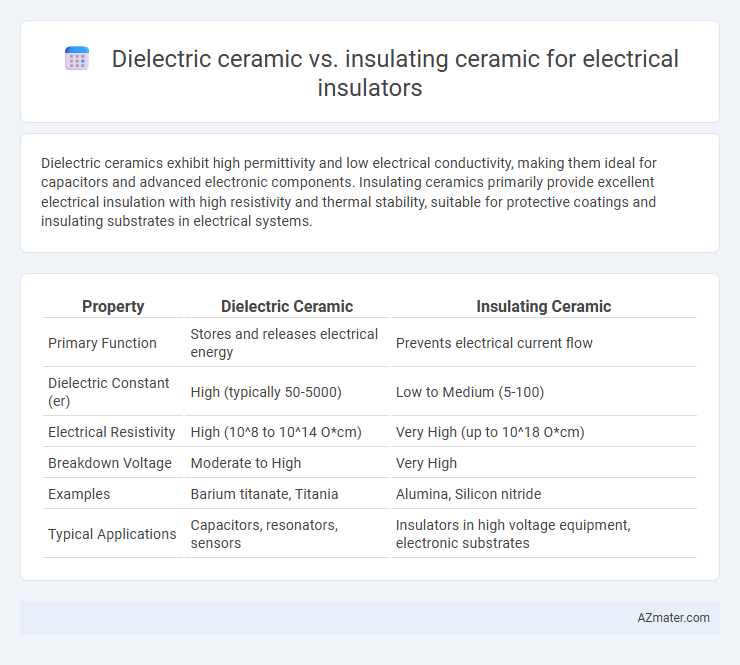Dielectric ceramics exhibit high permittivity and low electrical conductivity, making them ideal for capacitors and advanced electronic components. Insulating ceramics primarily provide excellent electrical insulation with high resistivity and thermal stability, suitable for protective coatings and insulating substrates in electrical systems.
Table of Comparison
| Property | Dielectric Ceramic | Insulating Ceramic |
|---|---|---|
| Primary Function | Stores and releases electrical energy | Prevents electrical current flow |
| Dielectric Constant (er) | High (typically 50-5000) | Low to Medium (5-100) |
| Electrical Resistivity | High (10^8 to 10^14 O*cm) | Very High (up to 10^18 O*cm) |
| Breakdown Voltage | Moderate to High | Very High |
| Examples | Barium titanate, Titania | Alumina, Silicon nitride |
| Typical Applications | Capacitors, resonators, sensors | Insulators in high voltage equipment, electronic substrates |
Introduction to Electrical Insulators
Dielectric ceramics and insulating ceramics both serve as electrical insulators, preventing current flow and ensuring safety in electrical systems. Dielectric ceramics primarily focus on storing and releasing electrical energy through their high permittivity and low dielectric loss, making them ideal for capacitors and high-frequency applications. Insulating ceramics, characterized by high electrical resistivity and thermal stability, provide robust barriers against electrical conduction in various industrial and electronic components.
Understanding Dielectric Ceramics
Dielectric ceramics are specialized materials designed to store and release electrical energy efficiently, characterized by high dielectric constants and low dielectric loss, making them crucial in capacitors, resonators, and insulating layers. Unlike general insulating ceramics, which primarily resist electrical current flow, dielectric ceramics specifically manage electric fields and polarization properties for enhanced performance in electronic components. Understanding the microstructural composition, such as grain boundaries and dopants, is essential for optimizing dielectric ceramics' electrical permittivity, breakdown strength, and temperature stability in advanced electrical insulation applications.
Understanding Insulating Ceramics
Insulating ceramics, such as alumina and zirconia, exhibit high electrical resistivity and low dielectric loss, making them ideal for preventing current flow in electrical systems. Dielectric ceramics, including barium titanate and lead zirconate titanate, are optimized for storing and releasing electric energy due to their high dielectric constant and polarization properties. Understanding the distinct roles of insulating versus dielectric ceramics enhances material selection for effective electrical insulation and capacitor applications.
Key Differences Between Dielectric and Insulating Ceramics
Dielectric ceramics exhibit high permittivity, enabling efficient energy storage and polarization under an electric field, while insulating ceramics primarily offer high electrical resistance to prevent current flow. Dielectric ceramics are often used in capacitors due to their ability to store electrical energy, whereas insulating ceramics serve as barriers in high-voltage applications to avoid electrical conduction. Key differences include dielectric constant, breakdown voltage, and loss tangent, with dielectric ceramics having optimized permittivity and insulating ceramics focusing on minimizing leakage currents.
Material Properties Comparison
Dielectric ceramics exhibit high permittivity and low dielectric loss, making them ideal for capacitors and high-frequency applications, while insulating ceramics prioritize high electrical resistivity and thermal stability to prevent current flow and withstand harsh environments. Key materials like alumina and zirconia provide superior mechanical strength and chemical resistance in both types, but dielectric ceramics are specifically engineered for enhanced polarization and energy storage. Insulating ceramics often have higher breakdown voltage and superior resistance to electrical degradation under stress, crucial for circuit protection and insulation components.
Applications of Dielectric Ceramics in Electrical Insulation
Dielectric ceramics exhibit high dielectric strength and low dielectric loss, making them ideal for capacitors, high-frequency insulators, and microwave substrates in electrical insulation. Their superior electrical resistivity and thermal stability enable use in sensors, actuators, and multilayer ceramic chip capacitors (MLCCs). Unlike insulating ceramics primarily used for mechanical protection and thermal barriers, dielectric ceramics are essential in applications requiring precise electrical insulation and energy storage.
Applications of Insulating Ceramics in Electrical Insulation
Insulating ceramics are widely utilized in electrical insulation applications due to their high resistivity and excellent dielectric strength, making them ideal for components such as insulators in power lines, substrates in electronic circuits, and protective housings for electrical devices. These ceramics exhibit superior thermal stability and resistance to electrical breakdown, enabling their use in high-voltage transformers, capacitors, and circuit breakers. Unlike dielectric ceramics, insulating ceramics prioritize maximum electrical resistance to prevent current flow, ensuring safety and reliability in various electrical and electronic systems.
Performance Factors: Dielectric vs Insulating Ceramics
Dielectric ceramics exhibit high permittivity and low dielectric loss, making them ideal for capacitors and high-frequency applications by efficiently storing and releasing electrical energy. Insulating ceramics prioritize high resistivity and thermal stability to prevent electrical conduction and withstand harsh operating conditions, crucial for protective coatings and insulators in power systems. Performance factors like dielectric constant, breakdown voltage, and temperature coefficient distinctly influence the suitability of dielectric ceramics for energy storage versus insulating ceramics for electrical isolation.
Selection Criteria for Electrical Insulators
Dielectric ceramics exhibit high permittivity and low dielectric loss, making them ideal for capacitors and applications requiring efficient electric field storage, whereas insulating ceramics prioritize high resistivity and breakdown voltage to prevent current flow and ensure electrical isolation. Selection criteria for electrical insulators focus on the operating voltage, thermal stability, mechanical strength, and environmental conditions such as moisture and chemical exposure. Materials like alumina and zirconia are preferred in high-temperature or harsh environments due to their superior dielectric strength and mechanical robustness.
Future Trends in Ceramic Electrical Insulators
Dielectric ceramics, characterized by high permittivity and low dielectric loss, are increasingly favored over traditional insulating ceramics for advanced electrical insulators due to their superior energy storage capabilities and efficiency in high-frequency applications. Future trends emphasize the integration of nanostructured dielectric ceramics to enhance breakdown voltage and thermal stability, supporting the demands of next-generation power electronics and miniaturized devices. Research into composite ceramics combining dielectric properties with mechanical robustness aims to create versatile insulators capable of operating under extreme environmental conditions and elevated electrical stresses.

Infographic: Dielectric ceramic vs Insulating ceramic for Electrical insulator
 azmater.com
azmater.com